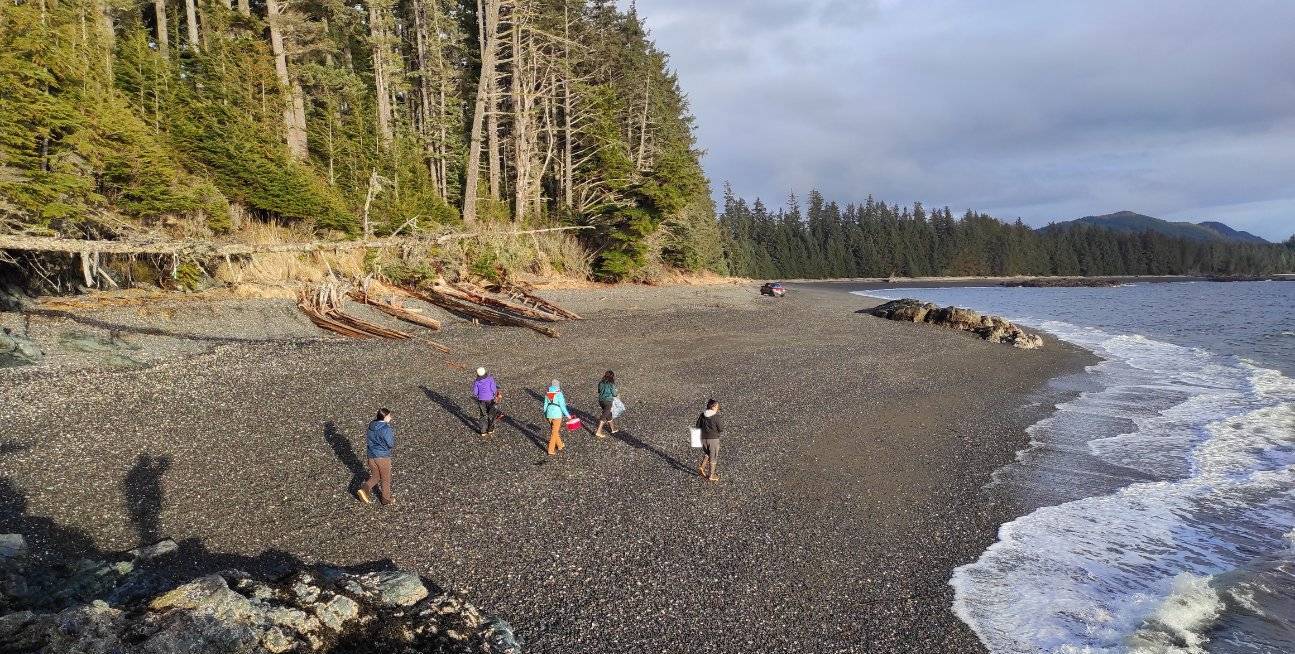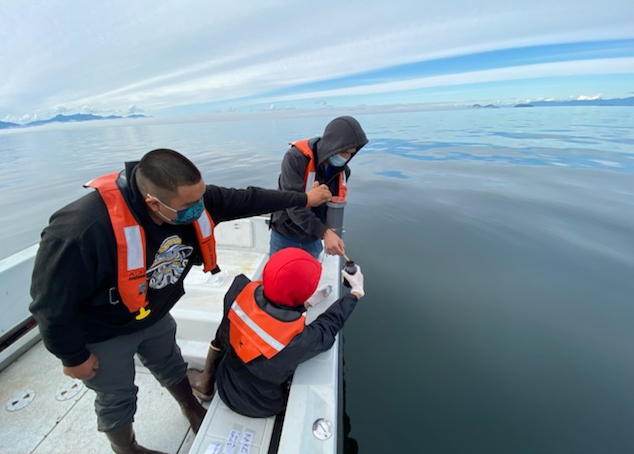Building a local climate workforce through science that serves
Heather McFarland
907-474-6286
Mar. 16, 2022
Most definitions of science focus on the pursuit of knowledge through rigorous and systematic investigation. For the Kake Climate Partnership, that isn’t enough.
“We’re trying to go a step further by providing services for the tribe and community,” said Elizabeth Figus, who is leading the partnership with the tribe, tribal corporation and municipal government in Kake.

Local residents walk a beach on Kupreanof Island, just north of the community of Kake, during field work for the Kake Climate Partnership.
The partnership aims to understand nearby ocean changes and has already provided over 30 part- or full-time jobs for residents of the Southeast Alaska village. When the project ends, the local partners in Kake will jointly own all the data and govern how the findings are used.
Though Figus, with the University of Alaska Fairbanks International Arctic Research Center, expects the data from the partnership to be useful, the process is the real focus. As a postdoctoral researcher at IARC’s Alaska Center for Climate Assessment and Policy, she’s coproducing the research with Kake’s leaders. Together, they chose what to study, how to collect the data and who is involved.
Ultimately, Figus hopes, the research will help create a climate workforce in Kake, where local residents are well compensated for their time, receive useful training, and gain tools to monitor their environment in the long term and plan how to adapt to future climate changes.
Simon Friday is a student employed by the Kake Climate Partnership. He’s a psychology major at the University of Alaska Fairbanks and a member of the Organized Village of Kake tribe. During the COVID-19 pandemic, he was home working another job when Figus offered him additional part-time fieldwork.
He said yes, and he has continued to say yes since, a path he hopes other young people will follow.
“Say yes to every opportunity that you possibly can,” said Friday. “You never know what you’re going to learn from those experiences or the people that you might meet, and those can very well be the relationships that help you in undergrad or even graduate school.”
Though Friday does not intend to pursue a career in climate science, he emphasized that the skills he developed and people he met during the project support his goal of becoming “Dr. Friday” and practicing psychology.
Through the Kake Climate Partnership, Friday learned to appreciate research, got a taste of office work, saw firsthand the value of precise data handling and more. But his favorite experiences were those involving people and getting to work with his community to understand the world around them.

Simon Friday (back) and two other local residents gather water samples during the Kake Climate Partnership.
“I’m a people-oriented person just by nature, so sharing those moments with all of my closest friends, even if it was just a silent car ride, I valued because we’re all working towards this one goal,” said Friday.
In Kake, people are concerned about how global climate change will impact the community’s ability to harvest traditional foods. With help from Figus and UAF resources, they designed and initiated a long-term ocean monitoring study for tracking how saltwater environments near their community are changing. With the future in mind, they prioritized creating a framework so that the tribe and community can continue monitoring efforts after outside scientists have moved on.
The community is also concerned about pollution coming from tourist and shipping vessels. They decided to take advantage of the dramatically reduced ship traffic during the pandemic to create a baseline dataset. The team collected shellfish and ocean water samples, analyzing them for heavy metals and bacteria. They also measured things like ocean temperature, salinity, pH and nutrients to assess the overall ecosystem health.
“So far it’s a lot of good news,” said Figus. The 2020-2021 results showed mostly clean, healthy ocean waters.
There is now a starting point to compare future data. Twenty years from now, the tribe and community in Kake will be able to see how the ocean has changed. While documenting changes, they also hope to come up with ways to decrease negative impacts from climate change on their traditional foods.
113-22


